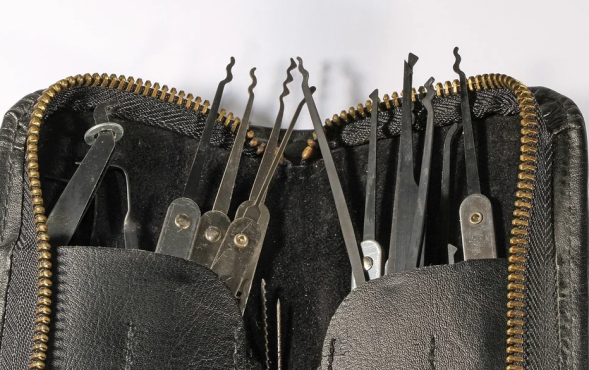Quick Navigation
Forgetting your garage keys happens to every person more often than you would think. In fact, I have been stuck like that on multiple occasions, waiting on the locksmith to come and open the garage door lock for me. But that was all before I learned how to do it myself.

And so will you, hopefully, after you finish reading through our article today. We will show you a couple of easy ways to get your garage door lock to open when you can’t find your keys. In this how-to post, you will learn how to pick a garage lock like one of the pros. Even though it will probably take some practice for you to get to that level.
Nevertheless, persist, have patience with yourself, and keep practicing. You’ll get there eventually. But, for now, let’s first learn about the theory behind picking garage door locks and after that, you can get cracking.
Getting Started
We are not here today to talk about prevention, but we hope that you will also think of ways to protect yourself by learning how to pick a garage lock. It is not an easy feat without causing any damage to the lock or the door itself but can be learned quite easily with all the information that is available in this day and age.

The ways we will talk about in this guide don’t require any special lock picking tools or equipment, aside from a tension lever (or something that can be used like that), but will require a couple of regular household items. Things most of you probably already own or could easily purchase at your nearby market. We will teach you how to open garage door locks using a paperclip, a bobby pin, a coat hanger, or simply manually opening it from the inside.
How to Pick a Garage Door Lock with a Regular Paper Clip
To start us off, the paperclip method. This process will require the use of a paper clip and you will need to deform it a little bit. You could also use a lock picking kit and tools if you have them. That would make this feat a whole lot easier to accomplish.

Step 1 – To start you off, you will need to straighten the paperclip out, not all the way. And at its end, make a little tip faced upwards. This will help you feel and push the pins of the lock to get it to open.
Step 2 – After getting your tools ready to go, you can start. First, you will place your tension lever to keep tension on the lock. This is done by sliding it inside, slightly rotating it counterclockwise to maintain tension, and keeping it steady on the bottom edge. Next, you will also insert the paper clip to the end with its tip faced upwards, away from the other paper clip. That way you can feel all the pins inside of the lock.
Step 3 – After feeling for the pins, you need to apply pressure on them. This is done by pushing down on the handle of your pick, the paper clip in this case, and pushing the pins up. This step will need to be repeated until every single one of the tumblers in the lock has been lifted.
Step 4 – After that, you should be able to easily rotate the paperclip inside the lock and get it to open. Easier said than done though.
How to Pick Garage Door Locks with a Bobby Pin
Next up, comes pretty much the same method, only this time we will be using a bobby pin. The steps are the same, only getting your “tools” ready will be different.
Step 1 – Just like the paper clips, you will need to open up the bobby pin and bend it at a 90-degree angle. (1)
Step 2 – After that, take a knife or razor blade and cut off the rounded rubber tip on the straight side of the bobby pin, not the wavy one. This is the side that you will place inside the lock. The rest is the same as with the paper clip.
Step 3 – The only difference is that if you don’t have a tension lever, you can make one from a second bobby pin. That is done by bending the top third of the pin so that it forms a hook. Unlike the first pin, you shouldn’t spread both sides apart on this one. Instead, bend them both together in the same direction. You’ll use this one to turn the lock after you have picked it.
Open your Garage Door using a Coat Hanger
And the last unconventional method we prepared for you today is this one. Pulling the emergency latch using a regular coat hanger.
This method will require that you haven’t already placed any precautions against it in place. And it is really quite simple. You will just need to thread the coat hanger through the top of your garage door until you reach the emergency latch. After doing so, hook the cord around it and slowly pull on it to disengage the safety release. Now, just simply roll the door up by hand. Easy-peasy.
If you don’t have access to a coat hanger at the moment, just use some kind of a hooked wire. Just make sure that it’s stiff enough to pull the latch and finish the job.
Your Garage Door Might be your Biggest Liability

Before ending this article, we should mention that your garage door is actually one of the weakest links in your home security system. They are structurally weak and can be easily kicked open from the outside. Plus, no one thinks of securing the interior door of their garage, thinking that just the outer one is enough to deter any burglar from breaking in.
And after breaking into your garage, any thief would have a plethora of tools at their disposal which further helps them with the burglary. So, your entire house will be put at risk, just because of a flimsy garage door. (2)
With the methods listed here, you should also have learned something about the ways in which your garage door can be forced open by intruders from the outside. So, now you also have an idea of how to protect yourself from that, hopefully. Think about it and maybe take some extra steps to guarantee your safety.
Hopefully, we were of great help to every single one of you in learning how to pick a garage door lock. And next time, when something like this happens to you, you won’t just be standing still in front of your garage door waiting for help to arrive. You will probably be able to fix the problem yourself. That way, even if you are in a hurry, you can get the job done as soon as possible. But, remember, practice makes perfect. No one is usually successful on their first try.
Thank you for your attention and if you have any notes or any additional ways of getting in, please leave them down in the comments!
References:
(1) 90-degree angle – http://www.geom.uiuc.edu/~demo5337/Group3/angle.html
(2) liability – https://www.britannica.com/topic/liability-law
